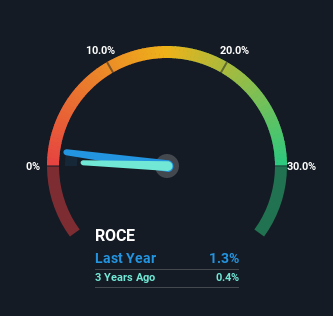- India
- /
- Real Estate
- /
- NSEI:MAXVIL
Max Ventures and Industries (NSE:MAXVIL) Might Be Having Difficulty Using Its Capital Effectively
Finding a business that has the potential to grow substantially is not easy, but it is possible if we look at a few key financial metrics. Firstly, we'll want to see a proven return on capital employed (ROCE) that is increasing, and secondly, an expanding base of capital employed. Put simply, these types of businesses are compounding machines, meaning they are continually reinvesting their earnings at ever-higher rates of return. In light of that, when we looked at Max Ventures and Industries (NSE:MAXVIL) and its ROCE trend, we weren't exactly thrilled.
Return On Capital Employed (ROCE): What is it?
For those that aren't sure what ROCE is, it measures the amount of pre-tax profits a company can generate from the capital employed in its business. To calculate this metric for Max Ventures and Industries, this is the formula:
Return on Capital Employed = Earnings Before Interest and Tax (EBIT) ÷ (Total Assets - Current Liabilities)
0.013 = ₹208m ÷ (₹17b - ₹538m) (Based on the trailing twelve months to March 2022).
So, Max Ventures and Industries has an ROCE of 1.3%. In absolute terms, that's a low return and it also under-performs the Chemicals industry average of 16%.
View our latest analysis for Max Ventures and Industries

Historical performance is a great place to start when researching a stock so above you can see the gauge for Max Ventures and Industries' ROCE against it's prior returns. If you're interested in investigating Max Ventures and Industries' past further, check out this free graph of past earnings, revenue and cash flow.
What Does the ROCE Trend For Max Ventures and Industries Tell Us?
In terms of Max Ventures and Industries' historical ROCE movements, the trend isn't fantastic. To be more specific, ROCE has fallen from 2.9% over the last five years. Given the business is employing more capital while revenue has slipped, this is a bit concerning. If this were to continue, you might be looking at a company that is trying to reinvest for growth but is actually losing market share since sales haven't increased.
On a side note, Max Ventures and Industries has done well to pay down its current liabilities to 3.2% of total assets. So we could link some of this to the decrease in ROCE. Effectively this means their suppliers or short-term creditors are funding less of the business, which reduces some elements of risk. Some would claim this reduces the business' efficiency at generating ROCE since it is now funding more of the operations with its own money.
The Bottom Line On Max Ventures and Industries' ROCE
We're a bit apprehensive about Max Ventures and Industries because despite more capital being deployed in the business, returns on that capital and sales have both fallen. Despite the concerning underlying trends, the stock has actually gained 30% over the last five years, so it might be that the investors are expecting the trends to reverse. Either way, we aren't huge fans of the current trends and so with that we think you might find better investments elsewhere.
Max Ventures and Industries could be trading at an attractive price in other respects, so you might find our free intrinsic value estimation on our platform quite valuable.
If you want to search for solid companies with great earnings, check out this free list of companies with good balance sheets and impressive returns on equity.
New: Manage All Your Stock Portfolios in One Place
We've created the ultimate portfolio companion for stock investors, and it's free.
• Connect an unlimited number of Portfolios and see your total in one currency
• Be alerted to new Warning Signs or Risks via email or mobile
• Track the Fair Value of your stocks
Have feedback on this article? Concerned about the content? Get in touch with us directly. Alternatively, email editorial-team (at) simplywallst.com.
This article by Simply Wall St is general in nature. We provide commentary based on historical data and analyst forecasts only using an unbiased methodology and our articles are not intended to be financial advice. It does not constitute a recommendation to buy or sell any stock, and does not take account of your objectives, or your financial situation. We aim to bring you long-term focused analysis driven by fundamental data. Note that our analysis may not factor in the latest price-sensitive company announcements or qualitative material. Simply Wall St has no position in any stocks mentioned.
About NSEI:MAXVIL
Max Ventures and Industries
Max Ventures and Industries Limited operates in the real estate business.
Questionable track record with imperfect balance sheet.
Market Insights
Community Narratives



